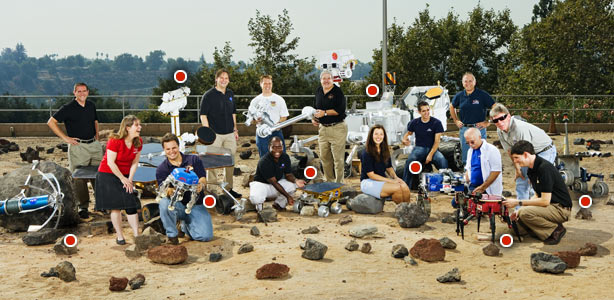Smart robots and their makers
Meet the talented team of NASA engineers who develop autonomous robots. Their latest: a 1,875-pound machine thatíll assess whether there was life on Mars. (Roll over red dots for more info.)

From left: Issa Nesnas, supervisor, robotic software systems; Ashley Stroupe, engineer; Anthony Ganino, engineer; Randy Lindemann, deputy section manager, instrument mechanical engineering; Brett Kennedy, engineer; Ashitey Trebi-Ollennu, engineer; Allen Sirota, supervisor, robotic hardware systems; Jessica Collisson, engineer; PabloAbad-Manterola, engineer; Charles Elachi, director of the Jet Propulsion Laboratory; Lee Magnone, technician; Mike Garrett, engineer; Avi Okon, engineer
Ah, the timeless question: Is there life on Mars? The staff of the Jet Propulsion Laboratory, a federally funded part of NASA that's managed by the California Institute of Technology, is helping bring us closer to finding the answer.
Developed on a 177-acre campus in Pasadena, JPL robots have landed on the moon, discovered that Mars once had water (a must for any life form), and scooped up surface samples of the Red Planet.
These autonomous robots are often crucial to JPL missions, which take an average of five years to develop and cost anywhere from $250 million to $1 billion. They can rappel down cliffs to survey a planet's layers or detect the amount of radiation in an atmosphere. They know how to avoid rocks and holes and replace screws on space stations. And they can endure the stress of extreme temperatures and the whipping winds from dust devils -- mini-tornados prevalent on Mars.
"A lot of the things at JPL have never been built before," says Allen Sirota, supervisor of the robotic hardware systems group, a team of 20 among the 5,000 engineers and scientists who work at JPL. "It's always new territory, and sometimes you don't know what the specific technology is or what the problems are going to be. That's what makes our jobs exciting."
The next mission for JPL is the 2011 launch of the Mars Science Lab, a nine-foot-long, 1,875-pound robot made mostly of aluminum and powered by a nuclear generator. It will carry 10 instruments to, among other things, investigate cycles of water, assess the atmosphere, and gather samples of rocks, which will be crushed and distributed to test chambers inside the rover.
While some of JPL's missions might seem arcane -- do we really need to know how many organic carbon compounds are on Mars? -- the technology used to make the robots translates into real-world applications.
A drone that detects moving objects becomes a powerful military tool when it can check a house for enemies before infantry enter or feed information to base camps via satellite. Robots like the ones above could go on to help companies harvest fields or speed up mining processes.
But while these versatile machines can do a lot of work on their own, they'd be nowhere without the team of engineers who built them.

